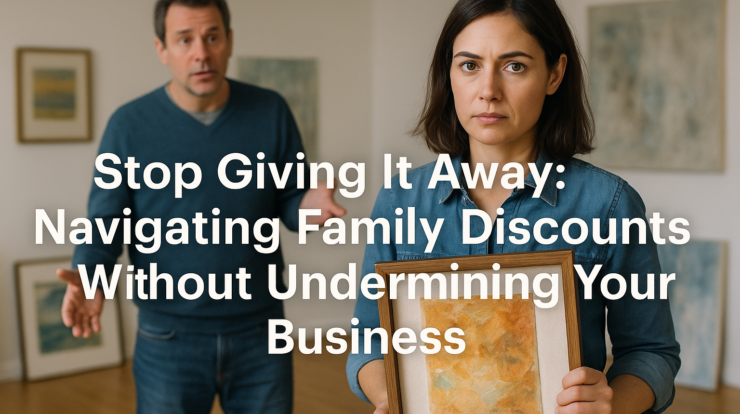
If you’re an artist, chances are someone close to you—an aunt, an old roommate, a second cousin twice removed—has said something like, “I love that piece… how much could I get it for?”
It’s a flattering question until you realize they’re expecting a discount deep enough to reach the earth’s core. Maybe even a freebie.
Navigating these requests is tricky, but it’s essential if you want to build a sustainable career. The goal isn’t to alienate your loved ones—it’s to help them see the value in what you do and give yourself permission to protect your business.
Let’s talk about how to handle these moments with grace, humor, and confidence.
You’re Not Being Greedy. You’re Running a Business.
The first thing to understand is that you’re not wrong to feel uncomfortable when someone expects a deep discount. What you’re offering isn’t just canvas and pigment—it’s hours of labor, years of training, emotional energy, and risk.
If you sold handmade furniture or ran a coffee shop, nobody would expect to walk out with a free sofa or unlimited espresso because they share your DNA. And yet, with art, people sometimes forget the rules of business apply.
It’s your job to remind them—gently, and with a smile.
When They Ask for a Deal
Here’s one simple way to respond when someone says, “What kind of price could I get?”
“That one is $2,000.”
And then… say nothing.
It’s natural to want to fill the silence with a discount, an apology, or a rationalization. Don’t. Just let the number land.
If they push back, you can offer something reasonable—but on your terms:
“Since you’re family, I can offer a 10% courtesy discount.”
Or:
“I’d be happy to split the payment over a few months if that helps.”
You’re treating them like a valued collector, not like someone who’s entitled to free labor.
Use Humor to Defuse the Awkwardness
Humor can be a great pressure release valve. One line I like to use:
“We offer a friends and family discount—$20 off anything in the gallery.”
If you’re standing in front of a $3,000 painting, the absurdity usually gets a laugh and lets you transition into a more realistic conversation about pricing.
Let Them Be Proud to Pay Full Price
Here’s the part we often overlook: some of your friends and family want to support you fully. They’re proud of your work. They know what it takes to create it. But if you assume they can’t afford it or wouldn’t want to pay full price, you rob them of the chance to show up for you.
There’s no shame in charging what your art is worth. In fact, there’s pride in it—both for you and for the person who gets to live with the piece.
Draw the Line Early and Kindly
If you’ve already set a precedent of giving your work away or offering deep discounts, changing course may take a few firm (but kind) boundaries. You can say:
“I’ve made a commitment to treat my art like a business. That means I have to be more consistent about pricing—even with people I love.”
Or:
“I’ve been too quick to give discounts in the past, and I realized it’s not sustainable if I want to keep doing this long-term.”
Most people will understand. The ones who don’t… well, that’s a whole different article.
It’s not unkind to charge for your art. It’s not awkward. It’s not selfish. It’s the only way to keep making the work you love—and sharing it with the people who love it too.
There have been times friends have bought my paintings. But mostly, although they love my art, and I know they would love to have it, people just don’t want to pay for it. I honestly can’t take it personally as a rejection of my work, because I know my work is very good. It’s just the rare person that wants to spend money on art, and that includes friends and family.
I’ve come to a place, and it’s taken me years, where I just give it away anyway. Otherwise it piles up and drags down my energy to make new art. It makes me sad to see it piled up. That sucks the life out of me.
I’ve painted all my life, although as a professional to earn a living I was a graphic designer. Now I have more time and can really explore my art journey. But the paintings have to go somewhere where they will bring someone joy, and if I don’t get money for it, it hurst a little, but not as much as the alternative.